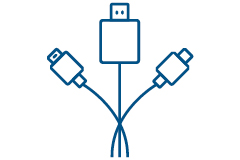Powered Up: Your Custom Power Banks Buying Guide
Picture it: you’re in the middle of nowhere with zero outlets to plug into. Your phone’s battery is at 18%. You have an important call to make and several emails to answer.
 Now you see the battery level is at 15%. With each passing second, it seems like the battery is draining even faster. The panic starts to set in.
Now you see the battery level is at 15%. With each passing second, it seems like the battery is draining even faster. The panic starts to set in.
Sound familiar? While smartphones and tablets provide plenty of convenience on the go, lack of battery power can render them useless. But thanks to custom power banks the days of relying on hope and limited outlets are numbered.
Here’s our list of key characteristics you’ll want to consider when looking for your next portable charger.
What do you mean by “capacity”?
To begin, the charge is measured in milliamp hours, also known as mAh. Older phones likely had capacities registering under 1,000 mAh, while modern ones can be up to 3,000 mAh.
Tablets have much larger batteries, so you’ll probably need a much bigger power bank if you want to charge a tablet. The same principle would apply to a laptop power bank.
 Look for a phone power bank with a higher capacity than your battery. For example an iPhoneX has a battery capacity of 2,716 mAh.
Look for a phone power bank with a higher capacity than your battery. For example an iPhoneX has a battery capacity of 2,716 mAh.
Imagine if you had a 10,000 mAh power bank, it’s likely you’ll be able to get three charges out of the power bank before having to recharge.
How fast can it charge?
 The current delivering the charge is measured in amps. Simply put, the lower the maximum current, the longer it will take to charge a device.
The current delivering the charge is measured in amps. Simply put, the lower the maximum current, the longer it will take to charge a device.
Even if some power bank chargers contain multiple outputs, the battery pack might not be able to deliver the maximum current to all outputs at the same time.
Smaller USB devices only expect a charge current of about half an amp, phones may take about an amp and tablets around 2.5 amps. If a device has fast-charging capabilities or are generally bigger (think laptop size), it’s going to require more current.
Connectivity is a thing?
 Multiple ports mean you can charge more than one device at a time. Just remember: the power bank might not deliver the maximum current to all outputs at once, and thus slowing down charging times.
Multiple ports mean you can charge more than one device at a time. Just remember: the power bank might not deliver the maximum current to all outputs at once, and thus slowing down charging times.
What about those charging cables?
 Pay attention to this area. Although most power banks come with a single full-size USB output port, make sure that each promotional battery pack you consider will actually plug into your phone successfully.
Pay attention to this area. Although most power banks come with a single full-size USB output port, make sure that each promotional battery pack you consider will actually plug into your phone successfully.
Key differences between Lithium-ion and lithium polymer
Lithium-ion and lithium polymer are two types of batteries used in cell phones, however, most smartphones available on the market have Li-Ion batteries.
Lithium polymer batteries, in a sense, are more advanced. Lightweight with no memory effect, the lithium polymer won’t heat up like a lithium-ion battery. And because the lithium polymer battery has no need for a protective circuit, manufacturers can create more compact versions for enhanced portability.
Lithium-ion batteries have a high energy density and are the most common and oldest battery technology available. Unlike the lithium polymer, Li-Ion features an active protective circuit that protects your phone or tablet from overheating.
Some power bank specifications will state whether they are lithium ion or lithium polymer, but not all.
Takeaways
A power bank should save you from headaches — not become one. By knowing the overall characteristics and understanding its output, the faster you can identify the type of power pack you’ll need to power on and power through your daily workload.
